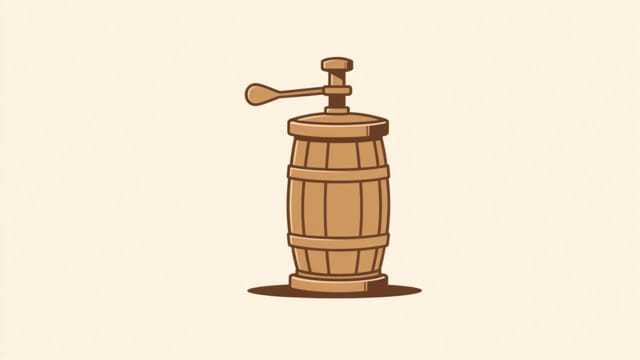For generations, people relied on traditional tools and methods to make everyday necessities at home. One such item is the butter churner, a classic device that symbolizes old-fashioned domestic life and self-sufficiency. The butter churner old fashioned style is more than just a piece of antique equipment it represents the art of homemade butter production, a slow yet rewarding process that offers insights into traditional lifestyles. Understanding how these devices work and their cultural significance can open a window into the history of food preparation, particularly in rural households of the past.
What Is a Butter Churner?
A butter churner is a tool used to convert cream into butter by agitating it until the fat separates from the liquid. The old-fashioned butter churner typically consists of a container, a handle, and a dasher or paddle inside. The process involves manually moving the handle to churn the cream. Over time, this movement causes the butterfat to clump together, forming butter, while the remaining liquid becomes buttermilk.
Types of Old-Fashioned Butter Churners
Several designs of butter churners were used historically, each with its own mechanism and appeal. Some of the most common old-fashioned types include:
- Dash Churn: A tall cylindrical container with a long handle or dasher that is moved up and down.
- Barrel Churn: A barrel-shaped container that rotates using a hand crank, mixing the cream inside.
- Paddle Churn: Features internal paddles turned by a handle on the outside of the container.
- Glass Jar Churn: Usually for smaller batches, it includes a glass jar with a crank on top that spins paddles inside.
The Process of Churning Butter
Making butter with an old-fashioned churner is a hands-on experience that requires patience and muscle power. The cream must be fresh and usually left at room temperature for a few hours to reach the ideal state for churning. Once placed in the churner, the operator begins moving the handle or dasher continuously for 20 to 40 minutes or more.
Steps to Churn Butter at Home
Using a butter churner old fashioned style at home involves several steps:
- Pour the room-temperature cream into the butter churner.
- Begin churning by rotating the handle or moving the dasher.
- As the cream thickens, continue churning until you notice the butter forming.
- Drain the buttermilk and rinse the butter with cold water to remove residual liquid.
- Knead the butter to remove excess moisture and add salt if desired.
Why Use an Old-Fashioned Butter Churner?
Although modern appliances can create butter more quickly, using an old-fashioned butter churner offers several unique advantages:
- Authenticity: It provides a true sense of connection with past generations who prepared their food by hand.
- Flavor: Homemade butter made with care often has a richer taste and creamier texture.
- Learning Experience: Churning butter is educational, especially for children learning about traditional food preparation.
- Control: You can adjust ingredients to your preference, such as using organic cream or skipping additives.
Preserving a Lost Art
Using a butter churner old fashioned style is a way of preserving a forgotten culinary art. For homesteaders, historical reenactors, or those seeking a more natural lifestyle, this practice is deeply meaningful. It serves not only a functional purpose but also brings historical charm to any kitchen.
Collectible Value and Aesthetic Appeal
Old-fashioned butter churners are not just useful they are also collectible antiques. Many people search for vintage churners made of wood, cast iron, or glass to display in kitchens or farmhouse-style homes. These pieces often tell a story of their era and craftsmanship, making them valuable as both tools and décor.
Where to Find Old-Fashioned Butter Churners
If you’re interested in owning a butter churner old fashioned design, you can often find them at:
- Antique stores
- Online marketplaces
- Estate sales
- Farm auctions
Be sure to check the condition, especially if you intend to use it for actual butter making. Look for signs of rust, wood rot, or broken components that could affect usability.
Butter Churners in Modern Times
While traditional butter churners are no longer standard kitchen tools, they remain relevant in niche communities. Homesteading movements, historical culinary schools, and sustainability advocates are all helping to bring butter churning back into focus. Some companies even produce replicas of old-fashioned churners for enthusiasts who want the experience without hunting down antiques.
Integrating Tradition into Today’s Lifestyle
For those passionate about food quality and tradition, using a butter churner the old-fashioned way is a rewarding hobby. It connects modern people to the heritage of hand-crafted food and fosters an appreciation for the time and effort involved in making something simple yet essential. In a world of instant gratification, slowing down to churn butter by hand can be surprisingly fulfilling.
The Charm of the Butter Churner Old Fashioned
The butter churner old fashioned model is more than a tool it’s a symbol of a time when life was slower, more deliberate, and more connected to nature. Whether used for practical purposes or collected for their historical charm, these devices remind us of our roots and the simple joy of making something from scratch. In an age dominated by convenience, revisiting traditional methods can provide not only better taste but also a deeper appreciation for the work that goes into creating quality food. Embracing old-fashioned practices, such as churning butter by hand, offers a meaningful bridge between past and present, blending nostalgia with the pursuit of a more authentic lifestyle.
